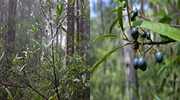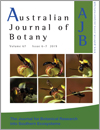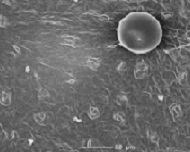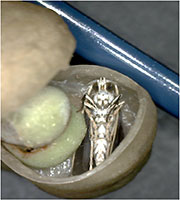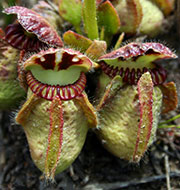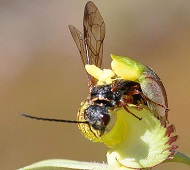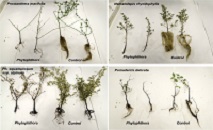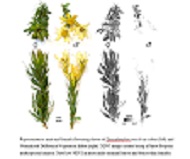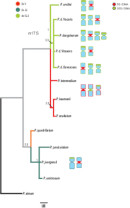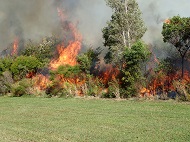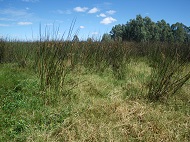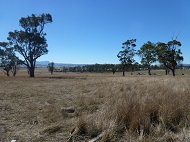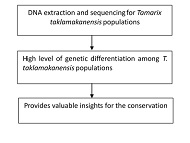Australian Journal of Botany
Volume 67
Numbers 6 & 7 2019
The recent climatic history of Australia shows cycles of very dry periods that contract our wet forest habitats into refuges, the nature of which varies for subtropical and cool-temperate lineages. The blueberry ash (Elaeocarpus reticulatus) is a common wet-forest tree in south-east Australia associating with both these forest types, and here we ask which evolutionary story this widespread species conforms to. Population genetic evidence shows that blueberry ash expanded into the south from northerly populations now associated with subtropical rainforest.
Nineteen Mentha taxa covering all four sections of the genus were grown under controlled conditions and leaf surfaces were examined for identification and discrimination of different mints and detection of variability among taxa. All taxa had large peltate and small capitate glandular trichomes. Most taxa had hypostomatous leaves, so amphistomatous leaves may be taxonomically and ecologically significant. Micromorphological parameters, along with genetic fingerprinting and chemotaxonomic classification, might provide further insight to the identity of Mentha taxa.
We studied the life history and reproduction of two intimately connected species, the tree Glochidion ferdinandi and the moth Epicephala colymbetella, which display obligate pollination mutualism: the moth reduces the number of viable seeds in the plant through consumption, but both the plant and moth rely completely on one another for their intricate pollination and egg laying behaviours. The Glochidion-Epicephala mutualism differs from most others in that adult moths were found to uniquely pupate and remain as adults within the fruit until fruit opened at maturation. This recently discovered form of pollination mutualism has evolutionary relevance.
Cephalotus follicularis is an ecologically unique carnivorous plant known only from small area of south-western Australia. Very little is known about its reproductive biology: this has hindered the establishment of conservation and management initiatives. This study determined that the seeds of C. follicularis possess morphophysiological dormancy, and examined the optimum conditions required for seed germination. Results highlight the importance of limiting hydrological alteration within the few remaining habitats that continue to support C. follicularis in order to preserve the species.
For translocations of plants with specialised pollination systems it is critical to identify the pollinating species and determine their presence at recipient sites. The endangered species Caladenia concolor and Caladenia arenaria are shown to be pollinated primarily by nectar-foraging thynnine wasps. For C. concolor the specialisation on one pollinator species means that pollinator availability needs to be taken into account before conservation translocations, while for C. arenaria, sharing of pollinators with related species means sites should be selected to avoid hybridisation.
Translocation, the establishment and augmentation of populations using ex situ material, can be used to save threatened plant species from extinction. Translocation is increasingly being recommended for threatened plant management in NSW, but there is a perception that translocation is less certain of a beneficial outcome, compared with other management actions. Using the principles of species extinction risk assessment, we argue that translocation is likely to be beneficial for species with very small populations and limited distributions (i.e. Critically Endangered species).
Phytophthora cinnamomi can infect many species and has the potential to cause extinction of rare ones. As an initial test, we trialled the susceptibility of 16 threatened species from NSW and found that seven were susceptible, three highly so. Further trials in this three year project will assess infection and management of these susceptible species.
After flowering, female plants must still allocate resources to cones, seeds and fruits, whereas males do not incur these costs. Does this mean that the costs of reproduction are higher for females than males? We argue the costs of reproduction are equal between the sexes in the dioecious Cape genus Leucadendron (Proteaceae).
The Dilatata group of Paspalum includes species from temperate South America, which have potential as useful forage grasses. Among the species in this group, five taxa are tetraploids and hybrids, and share the same origin and genome formula. We studied the genome restructuring of these taxa focussing on the dynamics of the rRNA genes. Results showed directional homogeneisation of sequences and loss and different numbers of rDNA sites, suggesting genome restructuring following polyploidy and independent ongoing processes taking place in each one.
Evaluations of translocation success are needed to improve their effectiveness in mitigating the negative effects of urbanisation on biodiversity. The success of a 15 ha subtropical heathland translocation and the effects of a fire management regime on it were investigated eight years after its completion. The translocation was found to be still successful 5 years since its last evaluation with fire management playing a critical role in its long-term success.
In a seed bank germination experiment we investigated the potential impacts of Juncus ingens, a native plant that has become invasive in Murray River floodplains historically dominated by Pseudoraphis spinescens grasslands. Invaded sites had a high density of emerged J. ingens seedlings, while very few seedlings of P. spinescens emerged at all and were mostly restricted to sites where vegetative P. spinescens swards were already present. These results show that restoration efforts should focus on conserving the remaining P. spinescens swards.
The classical model of publicly funded conservation is challenged within landscapes where almost all land is privately owned. Several private conservation reserves have been created in the Tasmanian Midlands to supplement the public reserve estate. We examined Eucalyptus population structures and ground layer composition to compare the effectiveness of public and private reserves. Invasion of exotic pasture species reduced the likelihood of Eucalyptus recruitment within small private conservation reserves, but areas with less human disturbance retained healthy tree populations.
Tamarix taklamakanensis is an endangered shrub endemic to north-western China. We found significant genetic divergence among the populations, and speculated climate oscillations might be the driver for the genetic divergence. Our study provides valuable insight into the conservation and management of T. taklamakanensis.
